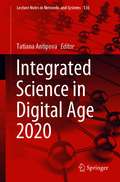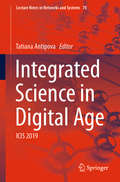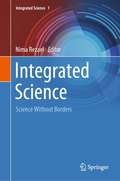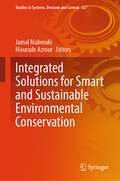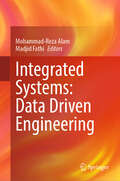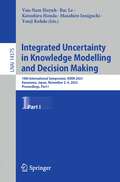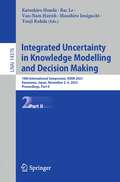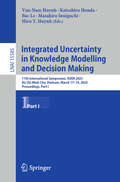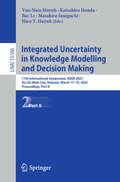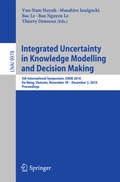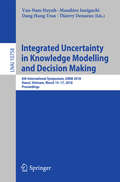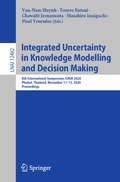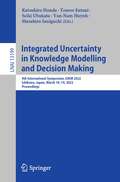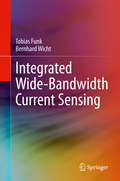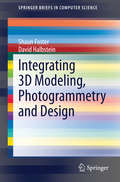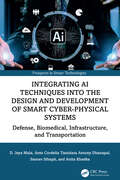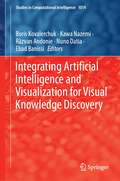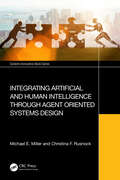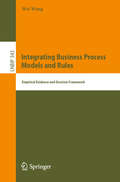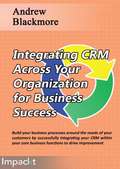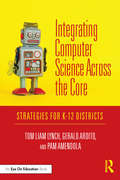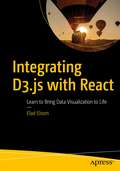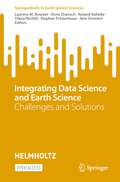- Table View
- List View
Integrated Science in Digital Age 2020 (Lecture Notes in Networks and Systems #136)
by Tatiana AntipovaThis book presents the proceedings of the 2020 International Conference on Integrated Science in Digital Age, which was jointly supported by the Institute of Certified Specialists (Russia) and Springer, and was held on May 1–3, 2020.The conference provided an international forum for researchers and practitioners to present and discuss the latest innovations, trends, results, experiences and concerns in the various areas of integrated science in the digital age. The main goal of the conference was to efficiently disseminate original findings in the natural and social sciences, covering topics such as blockchain & cryptocurrency; computer law & security; digital accounting & auditing; digital business & finance; digital economics; digital education; digital engineering; machine learning; smart cities in the digital age; health policy & management; and information management.
Integrated Science in Digital Age: ICIS 2019 (Lecture Notes in Networks and Systems #78)
by Tatiana AntipovaThis book gathers selected papers presented at the 2019 International Conference on Integrated Science in Digital Age (ICIS 2019), which was jointly supported by the Institute of Certified Specialists (ICS), Russia and Springer and held in Batumi, Georgia on May 10–12, 2019. The ICIS 2019 received roughly 50 contributions, by authors hailing from six countries. Following a peer-review process, the Scientific Committee – a multidisciplinary group of 110 experts from 38 countries around the globe – selected roughly 60% for publication. The main topics covered include: Artificial Intelligence Research; Digital Business & Finance; Educational Sciences; Health Management Informatics; Public Administration in the Digital Age; and Social Problem-solving.
Integrated Science: Science Without Borders (Integrated Science #1)
by Nima RezaeiThe “INTEGRATED SCIENCE: Science without Borders” is the first volume of INTEGRATED SCIENCE Book series, aims to publish the results of the most update ideas and reviews in transdisciplinarity fields, to highlight integration of different disciplines, including formal sciences, physical-chemical sciences and engineering, biological sciences, medical sciences, and social sciences. This is especially focused on the research involving the integration of two of more academic fields offering an innovative view, which is one of the main focuses of Universal Scientific Education and Research Network (USERN); science without borders. The whole world is suffering from complex problems; these are actually borderless problems; so, borderless solution could be the solution for such complex problems. Transdisciplinarity, as a domain that researchers work jointly, using shared conceptual framework drawing together disciplinary-specific theories, concepts and approaches to address common problem. Lack of confidence, lack of expertise, complexities of healthcare, the confusing nature of healthcare environments and lack of organization and standardization became obstacles to successful communication. Consequently, the book is to provide an overview of the basic elements of transdisciplinary studies and integrated science. The unique aspect of this book, privileging it from other books, is covering all aspects of science as a true one nature.
Integrated Solutions for Smart and Sustainable Environmental Conservation (Studies in Systems, Decision and Control #527)
by Mourade Azrour Jamal MabroukiResource depletion and ecological risks are more than ever at the heart of societal and economic debates. In the 1970s, the developed countries saw the Fordist growth regime crumble in parallel with the growing awareness of the ecological issue. Since the first industrial revolutions, technological dynamics have been the cause of many environmental problems, and there is a consensus on the diagnosis. Integrated technologies reduce resource use and/or pollution at source by using cleaner production methods. This generally leads to a reduction in the by-products, energy inputs and resources used by companies to produce goods. Integrated production technologies reduce negative environmental impacts at source by substituting or modifying cleaner technologies. Examples of integrated, or cleaner, production technologies are the recirculation of materials, the use of environmentally friendly materials (such as the substitution of water for organic solvents), etc. However, the implementation of integrated production technologies is often hampered by obstacles related to cost, coordination and skill inertia problems and to the productive organisation of companies. In addition to the high investment costs of new integrated technologies, additional barriers may emerge depending on the nature of the environmental problem and the type of environmental regulation in question.
Integrated Systems: Data Driven Engineering
by Madjid Fathi Mohammad-Reza AlamThe term "integrated system" denotes the seamless collaboration of numerous (potentially unrelated) subsystems to achieve a specific goal. It involves combining various components—hardware, software, networks, and workflows—into a unified system that operates cohesively. Widely utilized across scientific and technological domains, integrated systems aim to elevate coherence, efficiency, and overall functionality quality. The Integrated System Design and Technology (ISDT) conference convenes a distinguished group of leading scientists with diverse backgrounds and notable achievements in technological innovation with the goal of fostering cross-disciplinary research and innovation. This gathering serves as an enabler for addressing major scientific and societal challenges that necessitate integrated systems, emphasizing the importance of collaboration in overcoming complex issues. The book at hand includes peer-reviewed research results that were presented and critically discussed duringthe ISDT 2023 which were held in Antalya, Turkey, in May 2023.
Integrated Uncertainty in Knowledge Modelling and Decision Making: 10th International Symposium, IUKM 2023, Kanazawa, Japan, November 2–4, 2023, Proceedings, Part I (Lecture Notes in Computer Science #14375)
by Van-Nam Huynh Masahiro Inuiguchi Bac Le Katsuhiro Honda Youji KohdaThese two volumes constitute the proceedings of the 10th International Symposium on Integrated Uncertainty in Knowledge Modelling and Decision Making, IUKM 2023, held in Kanazawa, Japan, during November 2-4, 2023. The 58 full papers presented were carefully reviewed and selected from 107 submissions. The papers deal with all aspects of research results, ideas, and experiences of application among researchers and practitioners involved with all aspects of uncertainty modelling and management.
Integrated Uncertainty in Knowledge Modelling and Decision Making: 10th International Symposium, IUKM 2023, Kanazawa, Japan, November 2–4, 2023, Proceedings, Part II (Lecture Notes in Computer Science #14376)
by Van-Nam Huynh Masahiro Inuiguchi Bac Le Katsuhiro Honda Youji KohdaThese two volumes constitute the proceedings of the 10th International Symposium on Integrated Uncertainty in Knowledge Modelling and Decision Making, IUKM 2023, held in Kanazawa, Japan, during November 2-4, 2023.The 58 full papers presented were carefully reviewed and selected from 107 submissions. The papers deal with all aspects of research results, ideas, and experiences of application among researchers and practitioners involved with all aspects of uncertainty modelling and management.
Integrated Uncertainty in Knowledge Modelling and Decision Making: 11th International Symposium, IUKM 2025, Ho Chi Minh City, Vietnam, March 17–19, 2025, Proceedings, Part I (Lecture Notes in Computer Science #15585)
by Van-Nam Huynh Masahiro Inuiguchi Bac Le Katsuhiro Honda Hieu T. HuynhThis two-volume set constitutes the proceedings of the 11th International Symposium on Integrated Uncertainty in Knowledge Modelling and Decision Making, IUKM 2025, held in Ho Chi Minh City, Vietnam, during March 17-19, 2025. The 55 full papers in this book were carefully reviewed and selected from 116 submissions. They were organized in topical sections as follows: Part I: Invited Talks; Machine Learning; Pattern Recognition and Data Analysis; Applications. Part II: Uncertainty Management and Decision Making; Optimization and Statistical Methods; Applications.
Integrated Uncertainty in Knowledge Modelling and Decision Making: 11th International Symposium, IUKM 2025, Ho Chi Minh City, Vietnam, March 17–19, 2025, Proceedings, Part II (Lecture Notes in Computer Science #15586)
by Van-Nam Huynh Masahiro Inuiguchi Bac Le Katsuhiro Honda Hieu T. HuynhThis two-volume set constitutes the proceedings of the 11th International Symposium on Integrated Uncertainty in Knowledge Modelling and Decision Making, IUKM 2025, held in Ho Chi Minh City, Vietnam, during March 17-19, 2025. The 55 full papers in this book were carefully reviewed and selected from 116 submissions. They were organized in topical sections as follows: Part I: Invited Talks; Machine Learning; Pattern Recognition and Data Analysis; Applications. Part II: Uncertainty Management and Decision Making; Optimization and Statistical Methods; Applications.
Integrated Uncertainty in Knowledge Modelling and Decision Making: 5th International Symposium, IUKM 2016, Da Nang, Vietnam, November 30- December 2, 2016, Proceedings (Lecture Notes in Computer Science #9978)
by Van-Nam Huynh, Masahiro Inuiguchi, Bac Le, Bao Nguyen Le and Thierry DenoeuxThis book constitutes the refereed proceedings of the 5th International Symposium on Integrated Uncertainty in Knowledge Modelling and Decision Making, IUKM 2016, held in Da Nang, Vietnam, in November/December 2016.The IUKM symposia aim to provide a forum for exchanges of research results and ideas, and experience of application among researchers and practitioners involved with all aspects of uncertainty modelling and management.
Integrated Uncertainty in Knowledge Modelling and Decision Making: 6th International Symposium, IUKM 2018, Hanoi, Vietnam, March 15-17, 2018, Proceedings (Lecture Notes in Computer Science #10758)
by Van-Nam Huynh Thierry Denoeux Masahiro Inuiguchi Dang Hung TranThis book constitutes the refereed proceedings of the 6th International Symposium on Integrated Uncertainty in Knowledge Modelling and Decision Making, IUKM 2018, held in Hanoi, Vietnam, in March 2018.The 39 revised full papers presented in this book were carefully reviewed and selected from 76 initial submissions. The papers are organized in topical sections on uncertainty management and decision support; clustering and classification; machine learning applications; statistical methods; and econometric applications.
Integrated Uncertainty in Knowledge Modelling and Decision Making: 7th International Symposium, IUKM 2019, Nara, Japan, March 27–29, 2019, Proceedings (Lecture Notes in Computer Science #11471)
by Van-Nam Huynh Masahiro Inuiguchi Hirosato Seki Canh Hao NguyenThis book constitutes the refereed proceedings of the 7th International Symposium on Integrated Uncertainty in Knowledge Modelling and Decision Making, IUKM 2019, held in Nara, Japan, in March 2019.The 37 revised full papers presented were carefully reviewed and selected from 93 submissions. The papers deal with all aspects of uncertainty modelling and management and are organized in topical sections on uncertainty management and decision support; econometrics; machine learning; machine learning applications; and statistical methods.
Integrated Uncertainty in Knowledge Modelling and Decision Making: 8th International Symposium, IUKM 2020, Phuket, Thailand, November 11–13, 2020, Proceedings (Lecture Notes in Computer Science #12482)
by Van-Nam Huynh Masahiro Inuiguchi Tomoe Entani Chawalit Jeenanunta Pisal YenradeeThis book constitutes the refereed proceedings of the 8th International Symposium on Integrated Uncertainty in Knowledge Modelling and Decision Making, IUKM 2020, held in Phuket, Thailand, in November 2020.* The 35 full papers presented were carefully reviewed and selected from 55 submissions. The papers deal with all aspects of uncertainty modelling and management and are organized in topical sections on uncertainty management and decision support; machine learning; machine learning applications; econometric applications; and statistical methods. * The conference was held virtually due to the COVID-19 pandemic.
Integrated Uncertainty in Knowledge Modelling and Decision Making: 9th International Symposium, IUKM 2022, Ishikawa, Japan, March 18–19, 2022, Proceedings (Lecture Notes in Computer Science #13199)
by Van-Nam Huynh Masahiro Inuiguchi Katsuhiro Honda Tomoe Entani Seiki UbukataThis book constitutes the refereed proceedings of the 98th International Symposium on Integrated Uncertainty in Knowledge Modelling and Decision Making, IUKM 2021, held in Ishikawa, Japan, in March 2022. The 30 full papers presented were carefully reviewed and selected from 46 submissions. The papers deal with all aspects of uncertainty modelling and management and are organized in topical sections on uncertainty management and decision making, optimization and statistical methods, pattern classification and data analysis, machine learning, and economic applications.
Integrated Wide-Bandwidth Current Sensing
by Tobias Funk Bernhard WichtThis book provides readers with a single-source reference to current sensing integrated circuit design. It is written in handbook style, including systematic guidelines and implementation examples. The authors focus on the implementation of wide-bandwidth current sensing on a single microchip, toward usage in applications such as sensing, control and optimization of the energy flow in growth areas like industrial electronics, renewable energies, smart grids, electromobility and the Internet of Things.Provides readers with a comprehensive, all-in-one source for current sensing integrated circuit design, including implementation examples;Discusses modeling and optimization of on-chip Rogowski coil and Hall sensor in both lateral and vertical orientation;Includes noise reduction techniques, such as auto-zeroing and chopping;Covers open-loop and closed-loop sensor front-end design;Presents the first on-chip current sensor with a planar coil placed besides a power line to measure internal signal currents and the first off-chip current sensor with a helix-shaped coil for external signal currents in the multi-MHz region.
Integrating 3D Modeling, Photogrammetry and Design
by Shaun Foster David HalbsteinThis book looks at the convergent nature of technology and its relationship to the field of photogrammetry and 3D design. This is a facet of a broader discussion of the nature of technology itself and the relationship of technology to art, as well as an examination of the educational process. In the field of technology-influenced design-based education it is natural to push for advanced technology, yet within a larger institution the constraints of budget and adherence to tradition must be accepted. These opposing forces create a natural balance; in some cases constraints lead to greater creativity than freedom ever can - but in other cases the opposite is true. This work offers insights into ways to integrate new technologies into the field of design, and from a broader standpoint it also looks ahead, raising further questions and looking to the near future as to what additional technologies might cause further disruptions to 3D design as well as wonderful creative opportunities.
Integrating AI Techniques into the Design and Development of Smart Cyber-Physical Systems: Defense, Biomedical, Infrastructure, and Transportation (Prospects in Smart Technologies)
by D. Jeya Mala Anto Cordelia Dhanapal Saurav Sthapit Anita KhadkaBuilding on the knowledge of risks, vulnerabilities, and safety measures associated with cyber-physical systems, this book focuses on adapting artificial intelligence (AI) techniques to smart cyber-physical systems application development. The future is going to see cyber-physical systems in almost every aspect of life, so a book that focuses on shedding light on the design, development, and security aspects of cyber-physical systems in more crucial domains such as defense, healthcare, biomedical, smart city applications, is needed.Integrating AI Techniques into the Design and Development of Smart Cyber-Physical Systems: Defense, Biomedical, Infrastructure, and Transportation offers an introductory exploration of the fundamental theories and concepts of AI and machine learning (ML) that are utilized in the building of dependable cyber-physical systems. It brings the ideas of advanced design and development and empowered security measures to cyber-physical systems. By focusing on the application of AI in cyber-physical systems design as well as security aspects, an improvement in reliability and advancements can be explored. Also included are the latest findings and advancements as well as case studies and illustrative examples on the design and development of smart cyber-physical systems.This resource is highly valuable for those employed in educational institutions, research laboratories, enterprises, and government agencies, as well as for students seeking novel ideas in the realm of smart cyber-physical systems design.
Integrating Artificial Intelligence and Visualization for Visual Knowledge Discovery (Studies in Computational Intelligence #1014)
by Ebad Banissi Kawa Nazemi Boris Kovalerchuk Răzvan Andonie Nuno DatiaThis book is devoted to the emerging field of integrated visual knowledge discovery that combines advances in artificial intelligence/machine learning and visualization/visual analytic. A long-standing challenge of artificial intelligence (AI) and machine learning (ML) is explaining models to humans, especially for live-critical applications like health care. A model explanation is fundamentally human activity, not only an algorithmic one. As current deep learning studies demonstrate, it makes the paradigm based on the visual methods critically important to address this challenge. In general, visual approaches are critical for discovering explainable high-dimensional patterns in all types in high-dimensional data offering "n-D glasses," where preserving high-dimensional data properties and relations in visualizations is a major challenge. The current progress opens a fantastic opportunity in this domain. This book is a collection of 25 extended works of over 70 scholars presented at AI and visual analytics related symposia at the recent International Information Visualization Conferences with the goal of moving this integration to the next level. The sections of this book cover integrated systems, supervised learning, unsupervised learning, optimization, and evaluation of visualizations. The intended audience for this collection includes those developing and using emerging AI/machine learning and visualization methods. Scientists, practitioners, and students can find multiple examples of the current integration of AI/machine learning and visualization for visual knowledge discovery. The book provides a vision of future directions in this domain. New researchers will find here an inspiration to join the profession and to be involved for further development. Instructors in AI/ML and visualization classes can use it as a supplementary source in their undergraduate and graduate classes.
Integrating Artificial and Human Intelligence through Agent Oriented Systems Design (Systems Innovation Book Series)
by Michael E. Miller Christina F. RusnockThis book departs from the assumption that Artificial Intelligence (AI) systems will provide a maximum advantage by replacing human cognitive processing. Instead, this book subscribes to the assumption that AI systems will provide a maximal advantage when the system is specifically designed to augment human intelligence. It provides methods for designing effective systems that include one or more humans and one or more AI entities and uses the approach that assumes automation does not replace human activity but fundamentally changes the structure of human work when AI is added to existing systems.Integrating Artificial and Human Intelligence through Agent Oriented Systems Design discusses the potential impact of AI on human work and life and explores why teamwork is necessary today for complex work environments. The book explains the processes and methods humans employ to effectively team with one another and presents the elements of artificial agents that permit them to function as team members in joint human and artificial teams. It discusses design goals and illustrates how the methods that have been used to model the complex interactions among human and artificial agents can be expanded to enable the design of interaction between them to make possible the attainment of the shared goals. Model-Based Systems Engineering (MBSE) tools that provide logical designs of human–agent teams, the AI within these teams, training to be deployed for human and artificial agent team members, and the interfaces between human and artificial agent team members are all covered. MBSE files containing profiles and examples for building MBSE models used in the design approach are featured on the author’s website (https://lodesterresci.com/hat).This book is an ideal read for students, professors, engineers, and project managers associated with designing and developing AI systems or systems that seek to incorporate AI.
Integrating Blockchain and Artificial Intelligence for Industry 4.0 Innovations (EAI/Springer Innovations in Communication and Computing)
by Sam Goundar R. AnandanThis book discusses the convergence of artificial intelligence (AI) and Blockchain and how they can work together to help reach the goals of Industry 4.0. The authors first discuss how AI and Blockchain can help increase performance in business. The authors go on to discuss how the technologies can integrate to provide a competitive edge for businesses through improvements in big data, which has allowed firms to organize huge datasets into structured components that computers can process quickly. The authors also cover security implications and how AI and Blockchain can act as a double-edged sword against cyber-attacks. Impacts in programming, calculations, robotization, robots, and equipment are also discussed. This book caters to an extensive cross-sectional and multi-disciplinary readership. Academics, researchers and their students in topics such as artificial intelligence, cyber-physical systems, ethics, robotics, safety engineering, and safety-critical systems should find the book of value.
Integrating Business Process Models and Rules: Empirical Evidence And Decision Framework (Lecture Notes in Business Information Processing #343)
by Wei WangThis book combines multiple research methods, experiment, survey, and design science, as well as traditional measurements and neurophysiological techniques that can capture a variety of cognitive behaviors in human information processing, providing more solid and comprehended research findings. While the focus of the book is the modelling of process models and rules, the methods and techniques used in this book can also be adopted and applied to broader conceptual modelling research incorporating a variety of notations (e.g. UML, ER diagrams) or ontologies.It is a revised version of the PhD dissertation written by the author at the School of Information Technology and Electrical Engineering of the University of Queensland, Australia. In 2018, the PhD dissertation won the "CAiSE PhD Award," granted to outstanding PhD theses in the field of information systems engineering.
Integrating CRM Across Your Organization for Business Success
by Andrew BlackmoreThis book is written for IT leaders across organizations, whether they are managers, project managers, or developers who are charged with integrating CRM into IT systems for business success.
Integrating Computer Science Across the Core: Strategies for K-12 Districts
by Tom Liam Lynch Gerald Ardito Pam AmendolaIntegrating Computer Science Across the Core is a guide to systematizing computer science and computational thinking practices in your school. While most books explain how to teach computer science as a stand-alone discipline, this innovative approach will help you leverage your existing curriculum to deepen and expand students’ learning experiences in all content areas. Effective, equitable, and sustainable, this blueprint provides principals, curriculum directors, directors of technology, and other members of your school or district leadership team with suggested organizational structures, tips for professional learning, and key resources like planning instruments.
Integrating D3.js with React: Learn to Bring Data Visualization to Life
by Elad ElromIntegrate D3.js into a React TypeScript project and create a chart component working in harmony with React. This book will show you how utilize D3 with React to bring life to your charts.Seasoned author Elad Elrom will show you how to create simple charts such as line, bar, donut, scatter, histogram and others, and advanced charts such as a world map and force charts. You'll also learn to share the data across your components and charts using React Recoil state management. Then integrate third-party chart libraries that are built on D3 such as Rechart, Visx, Nivo, React-vi, and Victory and in the end deploy your chart as a server or serverless app on popular platforms. React and D3 are two of the most popular frameworks in their respective areas – learn to bring them together and take your storytelling to the next level. What You'll Learn Set up your project with React, TypeScript and D3.jsCreate simple and advanced D3.js chartsWork with complex charts such as world and force chartsIntegrate D3 data with React state management Improve the performance of your D3 componentsDeploy as a server or serverless app and debug test Who This Book Is ForReaders that already have basic knowledge of React, HTML, CSS and JavaScript.
Integrating Data Science and Earth Science: Challenges and Solutions (SpringerBriefs in Earth System Sciences)
by Laurens M. Bouwer Doris Dransch Roland Ruhnke Diana Rechid Stephan Frickenhaus Jens GreinertThis open access book presents the results of three years collaboration between earth scientists and data scientist, in developing and applying data science methods for scientific discovery. The book will be highly beneficial for other researchers at senior and graduate level, interested in applying visual data exploration, computational approaches and scientifc workflows.
